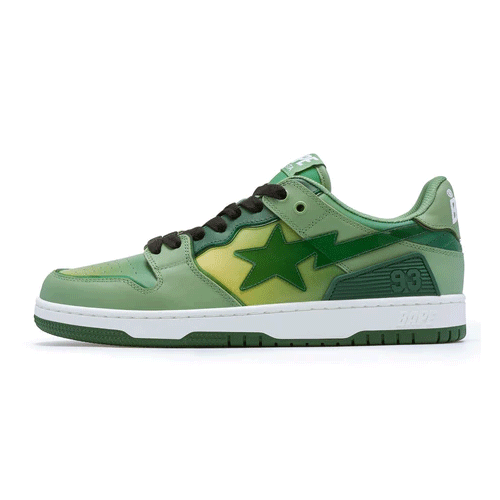The Bapesta, also known as the A Bathing Ape Bapesta, is one of the most recognizable sneakers in streetwear history. Designed by Japanese streetwear label A Bathing Ape (BAPE), the Bapesta first hit the scene in the early 2000s and immediately turned heads with its bold aesthetic, unapologetic colorways, and unmistakable resemblance to another iconic silhouette—the Nike Air Force 1.
But the Bapesta isn’t just a lookalike. It’s a cultural artifact, a symbol of rebellion, and a representation of how Eastern fashion can reinterpret Western icons. Over the years, the Bapesta has evolved from a niche curiosity to a must-have item, worn by hip-hop legends, fashion moguls, and sneakerheads worldwide.
The Origins of Bapesta: Nigo’s Vision
To understand the Bapesta, one must first understand its creator: Nigo. The founder of A Bathing Ape launched BAPE in 1993 with the aim of bringing American streetwear aesthetics into Japanese fashion culture. Inspired by brands like Supreme and designers like Hiroshi Fujiwara, Nigo envisioned a sneaker that captured the essence of American hip-hop and skate culture while delivering something fresh for his Japanese audience.
The Bapesta was officially introduced in 2002. Made of patent leather and often released in vibrant, mismatched colorways, the shoe quickly became a symbol of exclusivity and luxury. Unlike mainstream sneakers, Bapestas were produced in limited quantities and often sold out instantly, creating an air of mystique that continues to this day.
Similarities and Controversies: Air Force 1 Comparison
It’s impossible to talk about the Bapesta without addressing the elephant in the room: its similarity to the Nike Air Force 1. From the sole pattern to the overall shape, the resemblance is undeniable. The key difference lies in the branding. Instead of Nike’s Swoosh, the Bapesta features a star-shaped logo—commonly referred to as the “STA”—often accompanied by the brand’s ape head motif.
This design choice sparked considerable debate in sneaker circles. Some called it derivative, while others praised it as a clever remix of a cultural classic. Nigo has never shied away from the comparison, often stating that the Bapesta was intended as a tribute to the AF1, much like hip-hop artists sampling beats from old records. It’s a reinterpretation, not a replica.
Cultural Impact: From Tokyo to the World
What makes the Bapesta truly legendary isn’t just its design—it’s the culture it represents. When the shoe first dropped, it quickly caught the attention of American hip-hop artists like Pharrell Williams, Kanye West, and Lil Wayne. Pharrell even collaborated with BAPE on several exclusive Bapesta models through his Billionaire Boys Club brand, further propelling the shoe into the global spotlight.
These collaborations marked the beginning of BAPE’s mainstream explosion. It wasn’t just a Japanese brand anymore—it was a global streetwear force. The Bapesta became synonymous with luxury, rarity, and street credibility. Owning a pair wasn’t just about style; it was about status.
Evolution of the Bapesta: From Hype to Heritage
Over the years, the Bapesta has undergone several transformations. While the early 2000s were defined by loud colors and high-gloss materials, recent iterations have leaned into more refined aesthetics. From suede finishes to monochromatic colorways, the modern Bapesta now appeals to both nostalgic fans and a new generation of sneaker enthusiasts.
In 2020, BAPE announced a relaunch of the Bapesta line, reintroducing classic designs and unveiling new collaborations. This relaunch served as a reminder of the brand’s enduring legacy and its ability to evolve without losing its identity.
Today, the Bapesta is as much a part of sneaker history as the Air Jordan or the Yeezy. Its legacy lives on through countless customizations, reissues, and limited drops.
Collaborations That Changed the Game
BAPE is no stranger to collaborations, and the Bapesta has served as the canvas for some of the most coveted sneaker collabs in history. From comic book brands like Marvel to high fashion houses and music artists, the Bapesta has partnered with a wide variety of creatives.
One of the most famous collaborations remains the Kanye West “College Dropout” Bapesta, which featured bear logos inspired by his album cover. This limited release is now considered one of the most valuable and iconic Bapestas ever created.
Collaborations like these have helped solidify the Bapesta’s place in both sneaker and pop culture. They also highlight the brand’s ability to merge worlds—fashion, music, and art—into a single design statement.
Why the Bapesta Still Matters in 2025
With sneaker trends constantly shifting, some silhouettes fade into obscurity. Not the Bapesta. Even in 2025, it holds relevance because of its unique ability to blend nostalgia with modernity. The design hasn’t lost its edge, and with the resurgence of Y2K fashion and early 2000s aesthetics, the Bapesta fits perfectly into today’s fashion landscape.
Streetwear has become more than just a trend—it’s now a cultural movement—and the Bapesta stands as a testament to the roots of that movement. For collectors, wearing a pair is about more than style; it’s about honoring a legacy that shaped global streetwear culture.
Styling the Bapesta: How to Rock It Today
In the early 2000s, you might have seen Bapestas paired with oversized tees, baggy jeans, and chunky chains. While that look is making a bit of a comeback, the Bapesta today can be styled in countless ways. Try pairing it with slim joggers and a minimal bomber jacket for a clean, contemporary fit. Or go bold with a graphic hoodie and wide-leg denim for a nostalgic throwback.
The key to styling Bapestas is confidence. They’re loud shoes that demand attention, so don’t be afraid to let them be the focal point of your outfit.
Investing in Bapesta: Collector’s Insight
For those looking at sneakers as both a passion and an investment, Bapestas can be a smart pick. Vintage models, especially fashion the early 2000s, often resell for hundreds or even thousands of dollars. Rarity, condition, and collaboration are major value drivers.
If you’re looking to build a collection, start by exploring classic releases or recent collaborations. Keep an eye on trusted resell platforms and forums, and be cautious of fakes, which are unfortunately common due to the shoe’s popularity.
Final Thoughts: More Than Just a Sneaker
The Bapesta isn’t just footwear—it’s a statement. It represents decades of innovation, collaboration, and cultural exchange. From the streets of Harajuku to the stages of Coachella, the Bapesta has walked a long and impactful path.
Whether you’re a die-hard collector or just stepping into the world of sneakers, the Bapesta is a shoe that tells a story. And in a world where fashion is becoming increasingly fast and forgettable, that kind of story is worth preserving.


